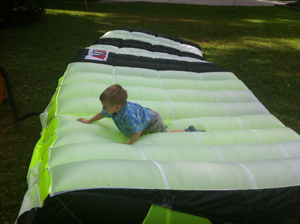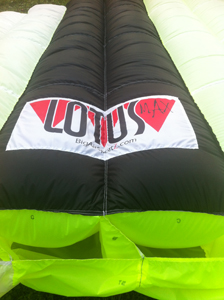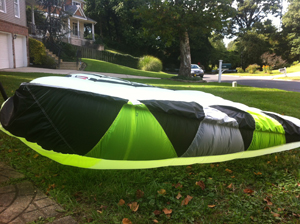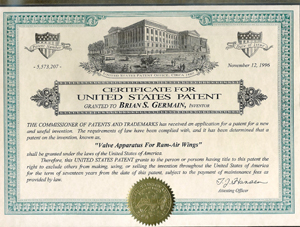Brian Germain's Store
Nature Therapy Experiences, Holistic Life Coaching, Books, Parachute Flight Instruction, Parachutes, and more!
Core Mission
It our core mission to help humanity grow more courageous, heart-driven and harmonious in our cooperation with the ecosystem and each other.
Renegade Airlock Parachute Deposit
Base price $2850
*Plus $100 per size over 150
Product Details
The Renegade is an all-around super fun wing. I designed it for wingsuiting, however it is not your typical wingsuit dog. It opens very consistently and on-heading as one might expect, and isn't likely to spin in linetwists, but it FLIES LIKE A DREAM! With airlocks, it is amazingly stable in turbulence.
Renegade Pilots report that it opens like a 7 cell and flies lands like an "8" cell. Finally, a wing that does it all. This is what I have in my own rig.
A canopy designed for the specific needs of a wingsuit pilot, the Renegade is a parachute for people who love to fly. The better you fly, the more you will love this wing. Are you a renegade pilot?
The Renegade is not your average 7 cell parachute. This is a wing. Although it opens predictably and is designed for wingsuit flying, this incredible flying machine is a joy in the air. The canopy is solid as can be in turbulence, playful on the controls, and has wonderful landings. We wanted to make a 7 cell perform like a 9 cell, and we did it.
Sculpted wingtips feature loaded stabilizer and tricell end cells. All the benefits of the lower aspect ratio on openings, and the flight performance that will impress even the most discerning canopy pilot.
Quick but soft on-heading openings, forgiving of line twists and even toggle-fires makes this a perfect parachute for wingsuit flyers. With the Renegade, pull-time is not the end of your flight, it is just the beginning of the fun.
Price $2850 USD
50% DEPOSIT TO BEGIN PRODUCTION
The longer you wait to place your order, the long you wait to get your parachute. Delivery time is still under 8 weeks.
Base price is still $2850, but not for long.
50% deposit necessary to hold your place in the production line (and so I can purchase your materials)
Few issues in parachute design have met with as much controversy as ram-air "Airlocks". Simply put, Airlocks are one-way valves in the leading edge of a ram-air canopy that maintain the internal pressurization. The intent of such valve parachutes is to prohibit instantaneous deflation of the airfoil, thus increasing the safety margin when flying in rough conditions. Although the author stresses that most of the ram-air canopies available today are very safe, the purpose of this article is to look toward the future of the ram air canopy, and the role that airlocks may play in this evolution.
A discussion of the empirical and theoretical issues relating to valve parachutes.
By Brian S. Germain
Origin of the Idea
When I was spiraling toward the earth with an 80% collapse, there was not enough inflated nylon over my head to slow my descent, or allow me to recover prior to impact. The landing put me in a wheelchair for many months, leading me to take serious interest in the valve idea. As I explored the many variations of airlock ideas, I soon realized that the game was fairly simple: Gather as much pressure as possible, and seal the wing off when the air tries to escape. Hence, the Germain Airlock allows the air to enter the wing in its normal pathway, sealing against the top-surface when necessary.
Discussion
Despite the availability of airlock designs since 1994, more than eighty five percent of the canopies sold are still devoid of this invention. This may be due to a lack of information about the advantages of the airlock design. Many jumpers still don't know exactly what an airlock is. Others believe that airlocks are just another unnecessary gimmick. Supporting this counter-airlock philosophy is the belief that even cell pressurization is all that is necessary to maintain a parachute is stability. In order to look closer at this perspective, we must first define what is meant by the term stability.
Primary Stability

This being said, the feeling of an airlock parachute in bumpy air is distinctly different from that of conventional designs. Since the air pressure maintaining the shape of the wing is relatively constant in an airlock parachute, the wing tends to distort and move around less than open-cell designs. This is very noticeable when flying in turbulence, during which an airlocked wing generally does not encounter significant span-wise oscillations, also called the accordion-effect.
The bottom line in primary stability is, however, does the canopy stay at the end of the lines? Some parachutes clearly do not, regardless of whether or not they have airlocks. If you pull on the front risers on a canopy that has sufficiently long brake lines and it bucks wildly or the leading edge bends under, it has bad primary stability, at least in that configuration. In other words, you cannot just sew airlocks into any parachute and expect it to be better in every way. It is not that simple.
Secondary Stability

Limits

Another limitation of the ram-air canopy is its ability to handle significant vertical air movement. A strong downdraft can increase your vertical speed beyond your canopy is ability to climb. Remember; even a rigid-wing airplane can crash in severe turbulence. There will always be a time for wise pilots to ground themselves. The old saying goes: It is better to be on the ground wishing you were in the air, than in the air, wishing you were on the ground.
Conclusions
All things considered, however, it makes a lot of sense that a parachute capable of maintaining its internal pressurization and surface area increases your chances of surviving. The most elegant, common sense ideas need little justification. Airlocks certainly fall into this category. We at Big Air believe that a ram air canopy is not complete without airlocks.
A Canopy is simply Air shaped into a wing... No Air... No Wing.
One must consider the fundamental definition of a cell. In biology, a cell is the smallest component of life as we know it. It is a self-contained entity, perhaps existing in cooperation with others, which defines itself in terms of its cell wall or cellular membrane a little bubble of energy. A living cell defends itself from outside forces, and therefore perpetuates its own existence. This is life at its simplest. A dead cell has no complete barrier to the outside world. It allows its internal volume to ebb and flow, amorphically maintaining equilibrium with the outside world. By airlocking a parachute, we give it a life of its own, and it will fight to stay alive.
Do airlocks increase the safety of the ram-air parachute? In most cases, yes. It is very similar to wearing a seatbelt on take-off. There are no guarantees that we will walk away from a crash, but I still always wear one. Many skydivers will continue to take a wait and see approach to airlocks, and this conservatism clearly has a strong component of sanity. Nevertheless, six years and over 2000 airlock canopies certainly are a compelling amount of evidence...
About Us

Brian Germain
store owner
Brian Germain is one of the most well known skydiving instructors in the world, and a multinational voice on the topic of holistic wellbeing. With tens of thousands of jumps over 40 years of continuous skydiving and adventure travel, Brian has learned much he can share to help you to become a happier, healthier, more effective human being. His many years of psychology study and many years of work as a Holistic Life Coach will provide you with a refreshing, uncommon perspective.
Brian's work on the topic of fear and its effects became crystallized in 1993 when tragic paraglider collapse nearly took his life. Rejecting the doctors’ proclamation that he would never jump again, Brian not only emerged from his wheelchair to continue skydiving, but just a few years later became the ESPN X-Games World Champion in Freefly Skydiving. His inspiring journey through and beyond fear has moved people all over the world to challenge their own personal boundaries, and expand who they are through taking fear head-on.
Brian's amazing recovery has led him to author numerous inspiring books and articles about overcoming fear and life challenges, including his best-seller Transcending Fear, the inspiring Green Light Your Life, Vertical Journey, and the world-renowned textbook of skydiving, The Parachute and its Pilot. His passion for the topic of fearless living has resulted in a barrage of interviews with the media, as well as his inspiring business keynote talks and experiential workshops. Brian's journey through apparent impasse has led him to many refreshing insights that will provide you with powerful secrets for handling stress in all its forms.
Brian Germain has dedicated his life to the study of fear and its antidotes, but what distinguishes him from others on similar paths is his unique ability to tell the story in an enjoyable way. His animated expression of this challenging aspect of the human experience is both profound and useful, and surprisingly funny. Brian's uncanny ability to paint the picture of the archetypal journey from fear to heroism has been fostered by many years of compassionate skydiving instruction.
Brian got his start as an Adventure Guide with Longacre Expeditions, focusing on rock climbing and mountaineering. After earning a BA in Psychology from the University of Vermont, Brian founded "Vermont Skydiving Adventures" parachute school at the age of twenty five, which he owned and operated for several years. At this small operation on the Canadian border, Brian trained many now-world-renowned skydivers with his unique and heart-driven methodology.
That is when his tragic paraglider collapse changed his life forever. For the next two years, Brian had to focus his efforts on the physical and mental healing process. As part of his path to recovery, he set his sights on preventing the same tragedy from befalling other parachutists. He faced his own fear by returning to the sky to test his own collapse-resistant "Airlock" prototypes, eventually founding his parachute design company BIG AIR Sportz. Brian's innovative work earned him a Patent for "Valved Apparatus for Ram-Air Canopies" (US Patent #5,573,207), a design that has been utilized in thousands of parachutes all over the world. He continues to build and test advanced parachute designs in order to improve safety and efficiency.
After writing the definitive book on parachute aerodynamics and safety, The Parachute and its Pilot, Brian created his world-renowned Parachute Flight Skills and Safety Course, an advanced training workshop for civilian and military parachutists. Brian continues to tour the world teaching parachuting safety, and is also the host of the very popular radio show entitled "Safety First with Brian Germain" on SkydiveRadio.com, as well as "BG Live", a revolutionary online training program on found at AdventureWisdom.com.
Brian Germain has many messages of great value from which anyone can benefit. The wisdom and positive outlook he has gathered applies directly to every aspect of life. The core skills that he teaches can help you to thrive in the midst of the most ominous leadership challenges, and help you to establish an emotional buoyancy that will make you the kind of person that others want to follow.
For Scheduling: Brian.transcendingfear@gmail.com (301) 646-0761
Transcending Fear is a Leadership Training Company. Our main offerings include: Fear Seminars by a noted Fear Expert for overcoming fears, Leadership Training Workshops, a celebrity Skydiving Instructor for skydiving fear challenges, and Skydiving Videos and Skydiving Books by Author Brian Germain.
Common Tags: Author Motivational Speaker, Fear Expert, Nature Guide, Forest Therapy, Forest Bathing, Nature Meditation, Skydiving Instructor, Keynote Speaker, Professional Skydiver, Inspirational Speaker, Business Motivational Speaker, Fear Author, Corporate Motivational Speaker, Skydive Instructor, Celebrity Skydiving Instructor, Skydiving Adventure, Skydiving Experience, Skydiving Training, Skydive Courses, Skydiving Safety, Skydiving Jumping, Top Motivational Speaker
©2006-2025 Brian Germain. All Rights Reserved

